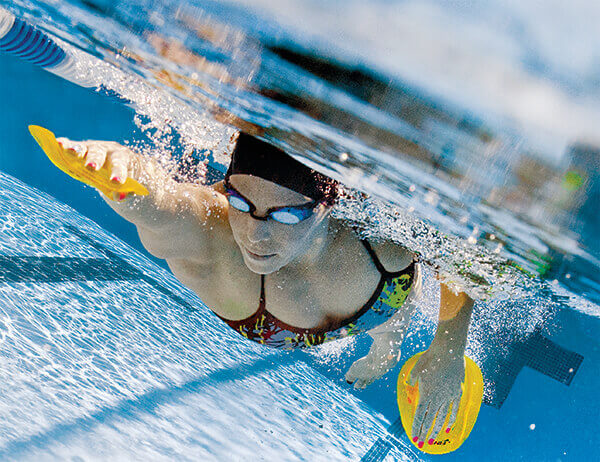How Hand Paddles Can Help Improve Your Technique

How Hand Paddles Can Improve Your Technique
By Vanessa Steigauf, Swimming World College Intern
Hand paddles are a piece of equipment almost every swimmer has in their bag. They help with generating power, training the upper limbs and shoulders, and developing a better feel for the water. That’s why paddles are also commonly used during meet warmups. But is it really a good idea to modify the surface area of your hand right before a race? And what are the differences between using paddles in practice and meet warmups? How does that weird feeling we have once we take the paddles off affect our performance? Some studies have taken a closer look at the biomechanics of hand paddles for swimmers and their effect on a swimmer’s stroke.
What Do Paddles Do to Your Stroke?
A hand paddle is simply an artificial enlargement of your hand area. It allows for greater propulsion by displacing a greater volume of water when you take a stroke. But as swimmers, we know there is so much more to paddles than this oversimplified description. Paddles increase our stroke length, swimming speed, and duration of pull and push phases of our strokes. At the same time, they decrease our average stroke rate and tempo. Scientists have also found, that with paddles, the phases of entry and catch become relatively shorter compared to the pull and push phases. Swimming with paddles, therefore, mixes up our stroke and can help us focus on the most important parts that create the necessary propulsion to overcome drag.
How Does That Make Us More Efficient?
From a biomechanical perspective, it seems like swimming should be a lot more exhausting with paddles. But overall, paddles can make our strokes a lot more efficient. While all the factors mentioned above seem to make swimming harder, scientists have also found that blood lactate levels stay roughly the same during a set swum with paddles, compared to swimmers doing the same set without paddles. That means that we have all the positive adaptations in our technique and strength without significantly more exhaustion. With paddles, you can get more out of your practice without higher muscle fatigue. From a biomechanical perspective, hand paddles for swimmers generate greater propelling efficiency instead of higher energy output. Put simply, we learn to use less power to swim faster.
Should We Always Swim with Paddles?
Swimming with paddles is not the magic compound that will turn you into a world-class swimmer, especially because the use of paddles needs to be chosen wisely. Simply using paddles during all your practices will not give you all the advantages discussed above. The magic happens the moment you take your paddles off. When you have your normal hand surface against the water after a set with enlarged surface area (i.e. paddles), is when most of the adaptation happens. You learn how to incorporate the newly practiced stroke and bring the efficiency into your normal swimming. At first, your hands might feel like tiny sticks swishing through the water totally uncontrolled. But focusing on that feeling and applying the newly learned efficiency is key to actually improving your technique.
Paddles During Practice vs. Meet Warmups
While paddles have more of a long-term effect on your efficiency when you regularly use them in practice, you want a relatively fast effect when using them in meet warm-ups. Therefore, it is important to incorporate paddles into your practice routine fairly often. You will need to get used to the feeling they create, especially the feel for the water after you take the paddles off. Sets where you swim longer distances with paddles and then take them off for short sprints can simulate a meet warmup and help your body get used to the immediate effects of paddles. If you regularly use paddles in practice and they help you to get a better feel for the water, you can also incorporate them in your meet warmup. As always, this decision heavily depends on personal preference.
Generally, hand paddles for swimmers are a great tool to improve upper-body strength and the efficiency of the stroke. While they bring those benefits without faster fatigue, they are especially helpful for distance swimmers and anyone who wants to spice up their practices without more exhaustion. Because of their positive effects on technique and stroke efficiency, they are equally useful for leisure swimmers, triathletes and competitive swimmers.
All commentaries are the opinion of the author and do not necessarily reflect the views of Swimming World Magazine nor its staff.



